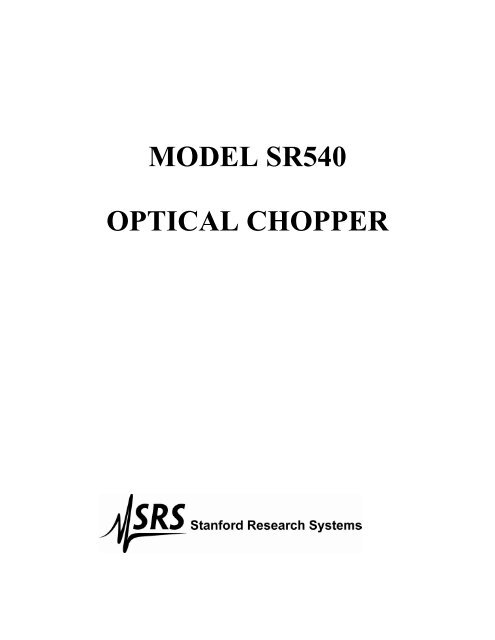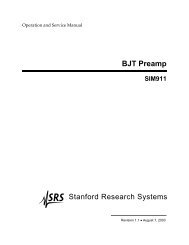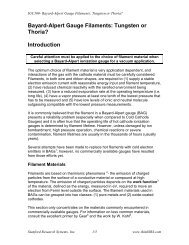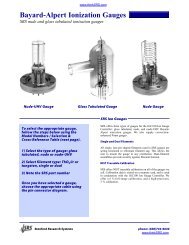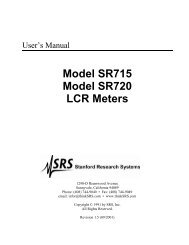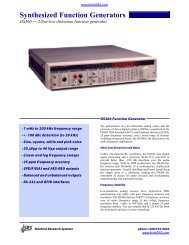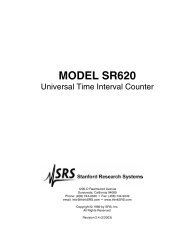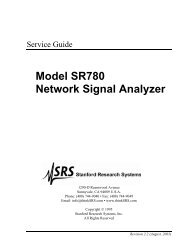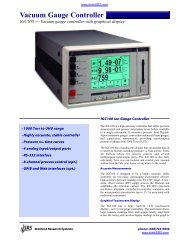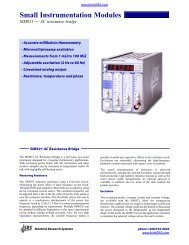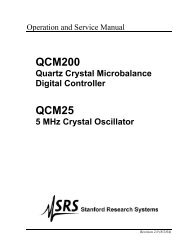You also want an ePaper? Increase the reach of your titles
YUMPU automatically turns print PDFs into web optimized ePapers that Google loves.
MODEL SR540OPTICAL CHOPPER
MODEL SR540OPTICAL CHOPPERCopyright © 1986, 1988, 1995, 1997Stanford Research Systems, Inc.All Rights ReservedRev. 2.4Stanford Research Systems, Inc.1290-D Reamwood Ave.Sunnyvale, CA 94089 USA(408) 744-90402
TABLE OF CONTENTSSymbols used ………………………………………………………...………. 5Specifications ………………………………………………..………………. 6Safety & Preparation for Use …………………………………..……….. 7Quick Start Instructions ………………………………………………….. 8Operating InstructionsApplicationsIntroduction …………………………………………………………… 9Frequency of Operation ……………………………………………… 9Changing Blades ………………………………………………………. 9Baseplate Removal ……………………………………………………. 9Single Beam …………………………………………………………... 10Single Beam Chopping to 20 kHz …………………………………….. 11Dual Beam Experiments ………………………………………………. 13Detection at Sum & Difference Frequencies ………………………….. 14Variable Aperture ……………………………………………………... 14Calibration …………………………………………………………………… 15Circuit DescriptionMotor Speed Control ………………………………………………….. 16<strong>Optical</strong> Pick-Offs ……………………………………………………… 15Frequency Synthesis …………………………………………………... 16Frequency Display …………………………………………………….. 16Power Supplies ………………………………………………………... 17Parts List ……………………………………………………………………... 18PC Layout …………………………...……………………………………….. 21Schematic …………………………...………………………………………... 224
Quick Start Instructions1. Make sure the correct line voltage is selected, the correct fuse is installed, and the powerswitch is off.2. Connect the chopper head to the controller with the supplied coiled cord.3. Mount the 30 slot wheel for 400 Hz to 3.7 kHz or the 6 slot wheel for 4 Hz to 400 Hz,and set the MAX FREQ/SLOT switch on the front panel for the desired frequency range.4. Set the REFERENCE MODE switch 'up'. In this position the right BNC output is at ƒ,the chop frequency of the outer row of slots; and the left BNC output is at ƒ inner , the chopfrequency of the inner row of slots.5. Connect the lock-in's reference input to the output that corresponds to the row of slotsthat will be used.6. Turn the power switch on and adjust the 10-turn dial for the desired chop frequency.8
APPLICATIONSSINGLE BEAM EXPERIMENTIn this application, a single optical beam ischopped by the outer row of slots, and thereference output from the right BNC is used tolock the lock-in amplifier to a chop frequency(figure 5). Note, that the inner row of slotscould be used, in which case the reference fromthe left BNC would be used. In either case, theREFERENCE MODE switch is in the 'up'position.10
SINGLE BEAM EXPERIMENT WITHEFFECTIVE CHOP FREQUENCIES TO 20KHZIn certain situations very high chop frequenciesare desirable. For example, you can infer thelifetime of a fluorescent decay by measuring thephase shift between the light which excites thematerial and the fluorescent decay output.τ = tanø / 2πƒwhere ø is the observed phase shift, ƒ is thechop frequency, and t is the lifetime. Accuracyis improved by using a chop frequency,ƒ ~ 1 / 2πτso that small errors in the phase measurementwill not drastically affect the lifetime.When a small diameter beam is chopped by ablade, the light intensity vs. time is a squarewave,I(t) = Io (sin wt + 1/3 sin 3wt + 1/5 sin 5wt +…).Providing that the optical media is not saturatedby the light beam, the media will respondlinearly to each Fourier component. In this case,we are interested in the response at the 5thharmonic, for which the chopper controller has areference signal output at 5ƒ.To use this feature, set the REFERENCEMODE switch to the center position and use theleft BNC reference output as the reference inputto the lock-in amplifier (figure 6). The lock-inwill now detect the response from theexperiment at the 5th harmonic of the chopfrequency (up to 20kHz). Note that the11
amplitude of the 5th harmonic term will dependon beam size. For a beam with diameter b,using the 30 slot wheel with a slot aperture L,the amplitude of the nth harmonic is given by,a n = 4 L cos nπ (1 - b/L)n 2 π 2 b 2The amplitude of the 5th harmonic vs. beamsize is plotted in figure 7. If your beam is muchlarger than 0.5mm, you may wish to pass thebeam through an aperture or bring it to focus atthe chopper blade.12
DUAL BEAM EXPERIMENTSIn this arrangement, the output from a singlesource is split in two and chopped at twodifferent frequencies by the same chopper wheel(figure 8). One of the beams passes through theexperiment, while the other beam, a referencebeam, passes through a control arm. The beamsare recombined and sent to the same detector.Two lock-in's are used to detect the two signalswhich are at different frequencies. The signal atƒ corresponds to the control arm, the signal atƒ inner is the response from the experimental arm.If the detected signal in the experimental arm isratioed to the detected signal in the control arm,then effects due to changing source intensity anddetector efficiency are removed.Also note that each beam passes through onebeam splitter, reflects off one beam splitter, andreflects off one mirror, so that effects due tothese components are cancelled in the ratiooutput.13
DETECTION AT THE SUM &DIFFERENCE FREQUENCIESCertain applications require detection at the sumor difference frequency of two chopped beams.In figure 9, a source beam is split into two. Oneof the beams is chopped by the outer row ofslots on the wheel, the other is chopped by theinner row. By placing the REFERENCEMODE switch in the down position, the sumfrequency is available at the left reference BNCand the difference frequency is available at theright BNC.VARIABLE APERTUREIn some situations one must reduce the dutycycle of a chopped optical beam. This can bedone with the SR540 by mounting two identicalblades and staggering their position relative toeach other.The minimum slot aperture is about 0.5mm,below which the slotted optical detector will failto detect the outer row of slots. Thiscorresponds to a 10%duty cycle on the 30 slotblade and a 2% duty cycle on the 6 slot blade.For duty cycles less than 20%, you should selectthe "pulse mode" reference level on the lock-in.Since the ƒ/6 notch is obscured when two bladesare mounted, only the ƒ & 5ƒ reference outputswill work (ƒ inner , ƒ sum , and ƒ diff will not work).You may observe the duty cycle of the choppedbeam on the ƒ output.14
CALIBRATIONOnly one adjustment is required to calibrate theSR540 <strong>Chopper</strong> Controller. The adjustment potlocated on the rear panel is used to match thecontroller to the motor. Mount the 30-slotblade, and set the MAX FREQ/SLOT switch to4 kHz. Set the FREQUENCY ADJUST dial to7.5, and use a small screwdriver to adjust theMOTOR CAL pot so that the four digit displayshows 3000 ±10 Hz.CIRCUIT DESCRIPTIONMOTOR SPEED CONTROLThe output of U5, a precision 10.000VDCreference, is attenuated by P2, the ten-turnpotentiometer, to control the motor speed. Theset voltage can be overridden by a voltage at theCONTROL VOLTAGE input. The speedcontrol voltage is buffered by 2/4 of U3, andattenuated by R8, R9 and R10. U2, a quadanalog switch, selects the attenuation factor toprovide full-scale voltages of 10.0, 5.0 or0.5VDC per the setting of the MAXFREQ/SLOTS switch. The 3/4 of U3 is used toamplify this voltage by about x2.6. TheMOTOR CAL pot, P1, is used to adjust the gainof this amplifier to compensate for variationsbetween motors. The output of the amplifier isbuffered by U1 to drive the motor. R4 sensesand limits the motor current to 200mA byturning on Q1. The 1/4 of U3 feeds-back avoltage equal to the voltage applied to the motorminus 4.7 times the voltage across R4. Sincethe feedback voltage goes down when current isincreased, the voltage applied to the motor willgo up; hence the output behaves like a negativeresistance connected to a voltage source. Thenegative resistance is about R4 x 4.7, ~ 15Ω.This is just equal to the real resistance of thecable and motor windings. With thisarrangement, the speed of the motor will not beaffected by load variations, which normallywould change the current and so change thevoltage that is applied to the motor. Thisimproves frequency stability of the chopper andimproves the linearity of the speed vs. controlvoltage characteristic.OPTICAL PICK-OFFSThere are two slotted optical switches, whichdetect slots in the chopper wheel. Each opticalswitch uses an infrared LED and aphototransistor. If the light passes through a slotto the phototransistor, its collector current willbe several milliamps. The collectors of thephoto transistors are connected together,summing their currents. The common collectoris held at 3.0VDC by 4/4 of U3. The current issensed by R15, so that the output of 4/4 U3 willswing by 1 volt/mA of collector current.Radiated noise at the chop frequency is greatlyreduced, as all lines going to the chopper headare held at constant voltage.The waveform at pin 14 of U3 looks like this:The current from one of the optical switches isjust a square wave at the frequency of the outerrow of slots. The outputs from the second photo15
transistor places a pulse on top of every sixthpulse, per the chopper wheel design. Thissecond signal provides a signal at f/6, withknown phase, which is used to synthesize otherreference outputs.Logic signals at f & f/6 are generated by the dualcomparator U6. The 1/2 of U6 compares thephoto current signal to a fixed voltage of about3.6VDC in order to generate f. The 2/2 of U6compares the photo current signal to the peakvalue of the photo current signal, less two diodedrops. Comparing to the peak voltagecompensates for variations in LED &phototransistor sensitivity. Both comparatorshave about 0.2V of hysteresis to preventmultiple edges on logic transitions.FREQUENCY SYNTHESISThe outer row frequency, f, is measured directlyby one of the phototransistors. The differencebetween the outer & inner row frequencies, f/6,is measured by the other phototransistor. Theother frequencies are synthesized from these tworeferences by a phase-lock loop circuit.Name Frequency Descriptionƒ ƒ outer row5ƒ 5ƒ 5 x outer rowƒ inner 5ƒ/6 inner rowƒ sum 11ƒ/6 outer row + inner rowƒ diff ƒ/6 outer row – inner rowThe Dual 1:4 Multiplexer, U17, is used to pass for f/6 to the right hand reference output BNCper the setting of the REFERENCE MODEswitch, SW1. U17 also selects f of f/6 as asource to the PLL frequency synthesizer circuit.To generate 5f/6, the frequency of the inner rowof slots, U17 selects f/6 as the input to the phasedetector of U12, a CMOS phase-lock loop. Theoutput of the phase detector is filtered by R23,R24, and C3. The quad analog switch, U4, willalso switch in C2 or C1 if the 400Hz or 40HzMAX FREQ/SLOTS ranges are selected atSW2. The filtered output of the phase detectorcontrols the VCO frequency. The maximumfrequency of the VCO is set by R22. U4increases the maximum frequency by switchingin R20 or R21 when the 400 Hz or 4KHz rangesare selected. The output frequency of the VCOis divided by U18, which is programmed todivide by 5 or 11 per the setting of theREFERENCE MODE switch, SW1. Togenerate 5f/6, U18 loads 10 when the counterreaches 15 to divide by 5. In order for thefrequencies at the input of the phase comparatorto be equal, the VCO must run at 5xf/6.The same circuit is used to generate 5f,however, the multiplexer, U17, selects f (notf/6) as the input to the phase detector. Togenerate 11f/6, the sum frequency, f/6 isselected as the input to the phase detector, andU18 is programmed to divide by 11 bypresetting to 4 when the counter reaches 15. Inall cases, the output of the VCO is passed to theleft reference output BNC. This output isalways a square wave.FREQUENCY DISPLAYThe four-digit frequency display always showsthe frequency, f, of the outer row of slots,independent of the reference mode, which hasbeen selected. The time base for the counter is a32,768Hz crystal oscillator, which is sustainedby U10, a hex inverter. U11, a 14-stage binarycounter and the flip-flop 2/2 U14 are used todivide by 215 to generate a 1.000-second gate.In order to eliminate one-count flicker in theresult, the count latch 1/2 U14, is set by a fallingedge of the wave form which is to be counted.When the count latch is set, the reset to the timebase counters is released, starting the onesecond-countperiod. Also, the reset to U15, thefour-decade counter/latch/display driver isreleased to begin the count. The countaccumulates for 1 second, when, the falling edgeof the Q output from 2/2 U14 sets 1/2 U13 high.The Q output of 1/2 U13 stays high for about1/2 clock period (15µs) asserting the LatchEnable input on U15 to transfer the countercontents to the latch for display. Then 1/2 U13is reset, and 2/2 U13 is clocked high, asserting16
the Q-bar output to reset the count latch. Theentire count cycle begins with the next fallingedge from the opto pick-off comparator. If thewheel stops, so there are no more pulses tocount, the reset to U15 will be assertedindefinitely. After a few seconds, R36 willcharge C13 to assert the Disp Sel to U15,causing the contents of the counters (which arezero) to be displayed instead of the contents ofthe latches (which contain the last count). U15multiplexes the display information to the 4digit common cathode LED. Each of the digitsare selected in sequence by U15 saturating oneof the display driver transistors Q2-Q5.POWER SUPPLIESThe power transformer primary is tapped foroperation at 100, 120, 220, or 240VAC. Thepower entry module does the requiredswitching. Full wave bridge rectifiers are usedto rectify the 7.5VAC and 30VAC to 8.5VDCand 40VDC. The unregulated 40VDC is usedby U1 the motor driver transistor, and by U8 toprovide regulated 30VDC. The 30VDC is theDC supply to U7, a +15VDC regulator. U9regulates the 8.5VDC to 5.0VDC.17
SR540 PARTS LISTMotor and Motor related Parts ListC 15 5-00102-517 4.7U Capacitor, Tantalum, 35V, 20%, RadJ 2 1-00030-100 4P4C Connector, Misc.M 1 7-00055-700 12VDC MotorO 1 3-00173-309 MOC70U2 <strong>Optical</strong> SwitchO 2 3-00173-309 MOC70U2 <strong>Optical</strong> SwitchPC1 7-00056-701 SR541 Printed Circuit BoardR 30 0-00000-000 UNDECIDED PART Hardware, Misc.R 33 0-00000-000 UNDECIDED PART Hardware, Misc.Z 0 0-00146-025 6-32X3/8H Screw, Allen HeadZ 0 0-00147-004 1/4-20X1" KnobsZ 0 0-00150-026 4-40X1/4PF Screw, Black, All TypesZ 0 0-00151-055 DC-44-4C-6 Wire, OtherZ 0 0-00205-058 EPOXY GLUE GlueZ 0 0-00222-021 6-32X1/4PP Screw, Panhead PhillipsZ 0 7-00057-720 SR540-1 Fabricated PartZ 0 7-00058-716 SR540-10 Chemically Etched PartZ 0 7-00059-721 SR540-2 Machined PartZ 0 7-00060-721 SR540-3 Machined PartZ 0 7-00061-721 SR540-6 Machined PartZ 0 7-00062-716 SR540-9 Chemically Etched PartMain Board and Chassis Assembly Parts List0 0-00238-026 6-32X1/4PF Screw, Black, All TypesBR1 3-00062-340 KBP201G/BR-81D Integrated Circuit (Thru-hole Pkg)BR2 3-00062-340 KBP201G/BR-81D Integrated Circuit (Thru-hole Pkg)C 1 5-00031-520 220U Capacitor, Electrolytic, 16V, 20%, RadC 2 5-00033-520 47U Capacitor, Electrolytic, 16V, 20%, RadC 3 5-00192-542 22U MIN Cap, Mini Electrolytic, 50V, 20% RadialC 4 5-00100-517 2.2U Capacitor, Tantalum, 35V, 20%, RadC 5 5-00127-524 2.2U Capacitor, Tantalum, 50V, 20%, RadC 6 5-00128-509 470U Capacitor, Electrolytic, 50V, 20%, RadC 7 5-00023-529 .1U Cap, Monolythic Ceramic, 50V, 20%, Z5UC 8 5-00038-509 10U Capacitor, Electrolytic, 50V, 20%, RadC 9 0-00001-000 WIRE Hardware, Misc.C 10 5-00064-513 .0047U Capacitor, Mylar/Poly, 50V, 5%, RadC 11 5-00100-517 2.2U Capacitor, Tantalum, 35V, 20%, RadC 12 5-00030-520 2200U Capacitor, Electrolytic, 16V, 20%, RadC 13 5-00038-509 10U Capacitor, Electrolytic, 50V, 20%, RadC 14 5-00023-529 .1U Cap, Monolythic Ceramic, 50V, 20%, Z5UC 17 5-00023-529 .1U Cap, Monolythic Ceramic, 50V, 20%, Z5UC 18 5-00100-517 2.2U Capacitor, Tantalum, 35V, 20%, RadC 19 5-00192-542 22U MIN Cap, Mini Electrolytic, 50V, 20% RadialC 20 5-00064-513 .0047U Capacitor, Mylar/Poly, 50V, 5%, RadCX1 5-00003-501 10P Capacitor, Ceramic Disc, 50V, 10%, SLCX2 5-00017-501 47P Capacitor, Ceramic Disc, 50V, 10%, SLD 1 3-00004-301 1N4148 DiodeD 2 3-00004-301 1N4148 DiodeDX100 3-00203-301 1N5711 DiodeF 1 6-00002-611 .25A 3AG Fuse18
SR540 PARTS LISTJ 1 1-00030-100 4P4C Connector, Misc.J 3 1-00031-133 16 PIN SRA Connector, Male, Right AngleP 1 4-00271-445 2.0K Pot, Multi-Turn, Side AdjustP 2 4-00019-443 20K Pot, 10-Turn PanelPC1 7-00054-701 SR540 Printed Circuit BoardPC2 7-00558-701 SR540 LED Printed Circuit BoardQ 2 3-00020-325 PN2222 Transistor, TO-92 PackageQ 3 3-00020-325 PN2222 Transistor, TO-92 PackageQ 4 3-00020-325 PN2222 Transistor, TO-92 PackageQ 5 3-00020-325 PN2222 Transistor, TO-92 PackageQ 6 3-00020-325 PN2222 Transistor, TO-92 PackageR 2 4-00273-401 5.6K Resistor, Carbon Film, 1/4W, 5%R 3 4-00305-401 4.3K Resistor, Carbon Film, 1/4W, 5%R 4 4-00773-402 2.2 Resistor, Carbon Comp, 1/2W, 5%R 5 4-00031-401 100 Resistor, Carbon Film, 1/4W, 5%R 6 4-00034-401 10K Resistor, Carbon Film, 1/4W, 5%R 7 4-00034-401 10K Resistor, Carbon Film, 1/4W, 5%R 8 4-00188-407 4.99K Resistor, Metal Film, 1/8W, 1%, 50PPMR 9 4-00187-407 4.53K Resistor, Metal Film, 1/8W, 1%, 50PPMR 10 4-00193-407 499 Resistor, Metal Film, 1/8W, 1%, 50PPMR 11 4-00061-401 240K Resistor, Carbon Film, 1/4W, 5%R 12 4-00034-401 10K Resistor, Carbon Film, 1/4W, 5%R 13 4-00048-401 2.2K Resistor, Carbon Film, 1/4W, 5%R 14 4-00078-401 39K Resistor, Carbon Film, 1/4W, 5%R 15 4-00021-401 1.0K Resistor, Carbon Film, 1/4W, 5%R 16 4-00272-407 221 Resistor, Metal Film, 1/8W, 1%, 50PPMR 17 4-00188-407 4.99K Resistor, Metal Film, 1/8W, 1%, 50PPMR 18 4-00021-401 1.0K Resistor, Carbon Film, 1/4W, 5%R 19 4-00059-401 22K Resistor, Carbon Film, 1/4W, 5%R 20 4-00614-407 174K Resistor, Metal Film, 1/8W, 1%, 50PPMR 21 4-00037-401 11K Resistor, Carbon Film, 1/4W, 5%R 22 4-00131-407 1.00M Resistor, Metal Film, 1/8W, 1%, 50PPMR 23 4-00094-401 6.8K Resistor, Carbon Film, 1/4W, 5%R 24 4-00090-401 560 Resistor, Carbon Film, 1/4W, 5%R 25 4-00054-401 200K Resistor, Carbon Film, 1/4W, 5%R 26 4-00035-401 10M Resistor, Carbon Film, 1/4W, 5%R 28 4-00021-401 1.0K Resistor, Carbon Film, 1/4W, 5%R 29 4-00034-401 10K Resistor, Carbon Film, 1/4W, 5%R 31 4-00032-401 100K Resistor, Carbon Film, 1/4W, 5%R 32 4-00032-401 100K Resistor, Carbon Film, 1/4W, 5%R 34 4-00057-401 220 Resistor, Carbon Film, 1/4W, 5%R 35 4-00057-401 220 Resistor, Carbon Film, 1/4W, 5%R 36 4-00032-401 100K Resistor, Carbon Film, 1/4W, 5%R 37 4-00034-401 10K Resistor, Carbon Film, 1/4W, 5%R 38 4-00034-401 10K Resistor, Carbon Film, 1/4W, 5%R 39 4-00273-401 5.6K Resistor, Carbon Film, 1/4W, 5%R 40 4-00024-401 1.2K Resistor, Carbon Film, 1/4W, 5%R 41 4-00031-401 100 Resistor, Carbon Film, 1/4W, 5%R 42 4-00021-401 1.0K Resistor, Carbon Film, 1/4W, 5%R 43 4-00059-401 22K Resistor, Carbon Film, 1/4W, 5%R 44 4-00021-401 1.0K Resistor, Carbon Film, 1/4W, 5%R 45 4-00022-401 1.0M Resistor, Carbon Film, 1/4W, 5%19
SR540 PARTS LISTR 46 4-00107-402 10 Resistor, Carbon Comp, 1/2W, 5%R 99 4-00081-401 470 Resistor, Carbon Film, 1/4W, 5%R 100 4-00355-435 56V/500A Varistor, Zinc Oxide Nonlinear ResistorSW1 2-00012-206 SPDT Switch, On-Off-On, Toggle,Right AngleSW2 2-00012-206 SPDT Switch, On-Off-On, Toggle,Right AngleT 1 6-00014-610 SR540 TransformerTH100 4-00766-431 RXE030 Thermistor, PTC (Positive Temp Control)U 1 3-00257-329 TIP41B Voltage Reg., TO-220 (TAB) PackageU 2 3-00074-340 CD4066 Integrated Circuit (Thru-hole Pkg)U 3 3-00098-340 LM324 Integrated Circuit (Thru-hole Pkg)U 4 3-00074-340 CD4066 Integrated Circuit (Thru-hole Pkg)U 5 3-00188-340 LH0070-0H Integrated Circuit (Thru-hole Pkg)U 6 3-00143-340 LM393 Integrated Circuit (Thru-hole Pkg)U 7 3-00114-329 7815 Voltage Reg., TO-220 (TAB) PackageU 8 3-00149-329 LM317T Voltage Reg., TO-220 (TAB) PackageU 9 3-00112-329 7805 Voltage Reg., TO-220 (TAB) PackageU 10 3-00051-340 74HCU04 Integrated Circuit (Thru-hole Pkg)U 11 3-00169-340 74HC4020 Integrated Circuit (Thru-hole Pkg)U 12 3-00072-340 CD4046 Integrated Circuit (Thru-hole Pkg)U 13 3-00048-340 74HC73 Integrated Circuit (Thru-hole Pkg)U 14 3-00048-340 74HC73 Integrated Circuit (Thru-hole Pkg)U 15 3-00170-340 74C926 Integrated Circuit (Thru-hole Pkg)U 17 3-00166-340 74HC153 Integrated Circuit (Thru-hole Pkg)U 18 3-00171-340 74HC191 Integrated Circuit (Thru-hole Pkg)XT1 6-00015-620 32.768 KHZ CrystalZ 0 0-00002-008 2607 DialZ 0 0-00009-000 FOOT Hardware, Misc.Z 0 0-00025-005 3/8" LugsZ 0 0-00048-011 6-32 KEP Nut, KepZ 0 0-00089-033 4" TieZ 0 0-00103-040 3/8X3/32 Washer, FlatZ 0 0-00127-050 4" #18 Wire #18 UL1007 Stripped 3/8x3/8 No TinZ 0 0-00128-053 4" #24 Wire #24 UL1007 Strip 1/4x1/4 TinZ 0 0-00129-053 5" #24 Wire #24 UL1007 Strip 1/4x1/4 TinZ 0 0-00134-053 7-1/4" #24 Wire #24 UL1007 Strip 1/4x1/4 TinZ 0 0-00149-020 4-40X1/4PF Screw, Flathead PhillipsZ 0 0-00153-057 GROMMET2 GrommetZ 0 0-00155-002 6VM4S Power_Entry HardwareZ 0 0-00185-021 6-32X3/8PP Screw, Panhead PhillipsZ 0 0-00207-003 TO-5 InsulatorsZ 0 0-00209-021 4-40X3/8PP Screw, Panhead PhillipsZ 0 0-00222-021 6-32X1/4PP Screw, Panhead PhillipsZ 0 0-00447-007 TO-220 Heat SinksZ 0 0-00524-048 8-1/4" #18 Wire, #18 UL1015 Strip 3/8 x 3/8 No TinZ 0 0-00594-050 4-1/2" #18 BLUE Wire #18 UL1007 Stripped 3/8x3/8 No TinZ 0 1-00003-120 BNC Connector, BNCZ 0 1-00053-172 USA Line CordZ 0 3-00556-340 HDSP-5323 Integrated Circuit (Thru-hole Pkg)Z 0 7-00064-720 SR540-7 Fabricated PartZ 0 7-00065-720 SR540-8 Fabricated PartZ 0 7-00066-709 SR540-11 Lexan Overlay20


